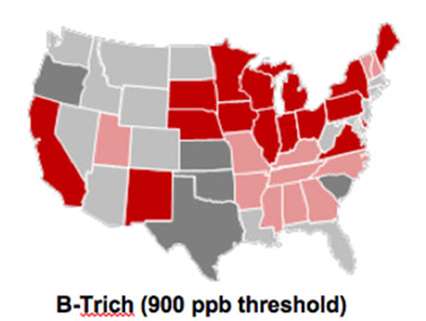Part 1 of mycotoxins in swine feed: Deoxynivalenol
What you don’t want in your pig feed. This series talks about two of the major mycotoxins affecting the northern United States and a part on how to alleviate their effects in the feed.
Introduction
As the 2018 harvest comes to an end, many are concerned about the abnormal growing season throughout the United States that started with dry, lack-luster weather and ended wet and sloppy. As the feed mills start dipping into the new crop, mainly corn and soybeans, the top priority is storage conditions since the wet fall created the optimal conditions for mycotoxins to thrive. Mycotoxins are defined as secondary metabolites that are produced by fungi and cause a toxic response when ingested by animals (Diekman and Green, 1992). The main mycotoxins in the United States are aflatoxin, deoxynivalenol, and zearalenone. The economic effect of these mycotoxins have been estimated annually at $0.5 to $1.5 billion per year, with corn yearly grossing $225 million per year (Bryden, 2012).
Deoxynivalenol

Deoxynivalenol is one of the most prevalent contaminants with major public health issues, having a concern in an increase with toxigenic potentials. Also known as vomitoxin it is primarily produced by Fusarium graminararum and F. culmorum (Li et al., 2011). The mold is most common in the upper Midwest and in Canada affecting mostly corn, wheat, and barley (Richard, 2007). Deoxynivalenol is the white-reddish color of mold on the grain after maturity, penetrating the host ear, floret or head blight. The mold develops in the cool, damp weather conditions and can survive as residue from the field from the previous season. Ideal conditions for the mycotoxin are at moisture levels above 20% and temperatures between 70 and 85°F. This mycotoxin does not proceed to grow further in storage and with good storage conditions and moisture levels below 14%; growth will stop growth (Richard, 2007).
Deoxynivalenol affects the immune system, mainly the epithelial cells of the gastrointestinal tract, which are the pig’s first line of defense (Li et al., 2011). Deoxynivalenol becomes an immunosuppressant or immunostimulant depending on the immune function it is influencing (Goossen et al., 2012).
Signs of Deoxynivalenol effect on Pigs |
|
Acute |
Chronic |
| Anorexia | Decrease feed intake |
| Vomiting | Decrease body gain |
| Diarrhea | Altering of immune function |
| Immunosupression | |
Immunosuppression
Table adapted from Li et al., 2011
Deoxynivalenol is monitored closely by various government organizations, thus dose levels are strict for all pigs, 1 µg/g (Chen et al., 2008). In research, 1 ppm will cause reduced feed intake, 5 ppm causes feed refusal, and 10 ppm will induce weight loss and vomiting. Pigs absorb this mycotoxin very quickly, especially in the small intestine. Detection in the blood can be seen within 30 minutes of intake and peak serum levels are shown within four hours of ingestion.



 Print
Print Email
Email




